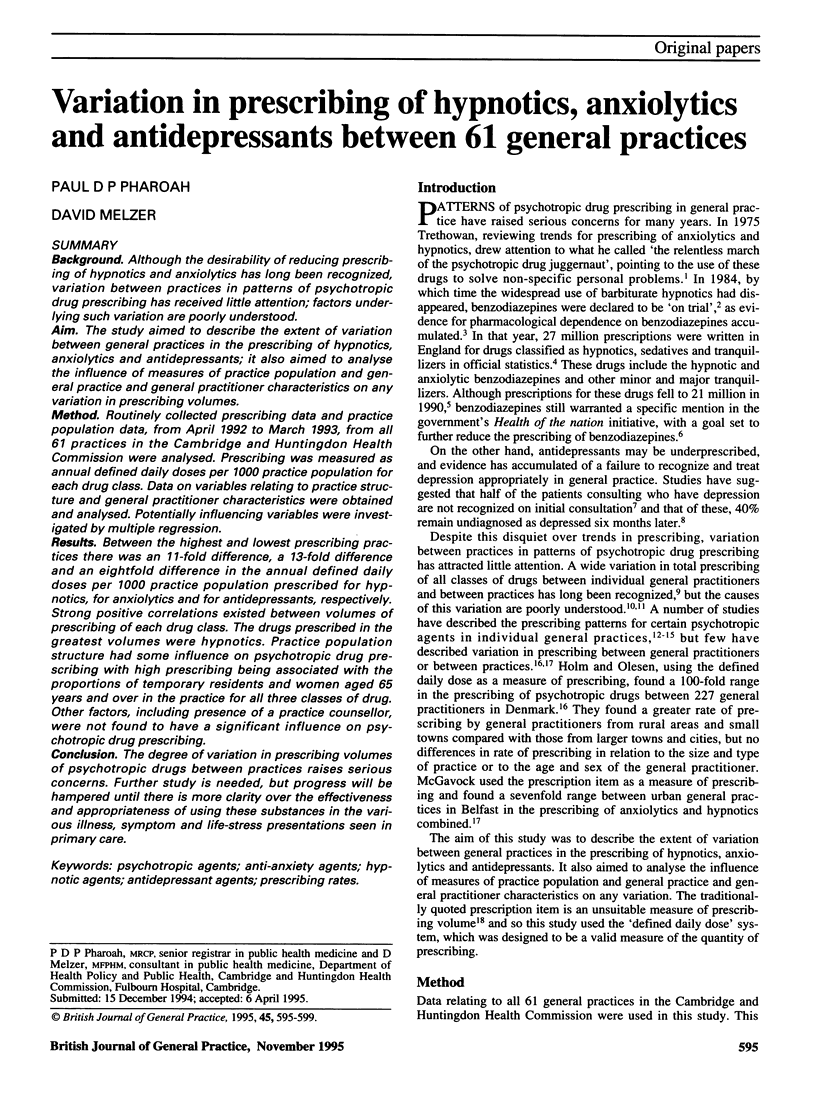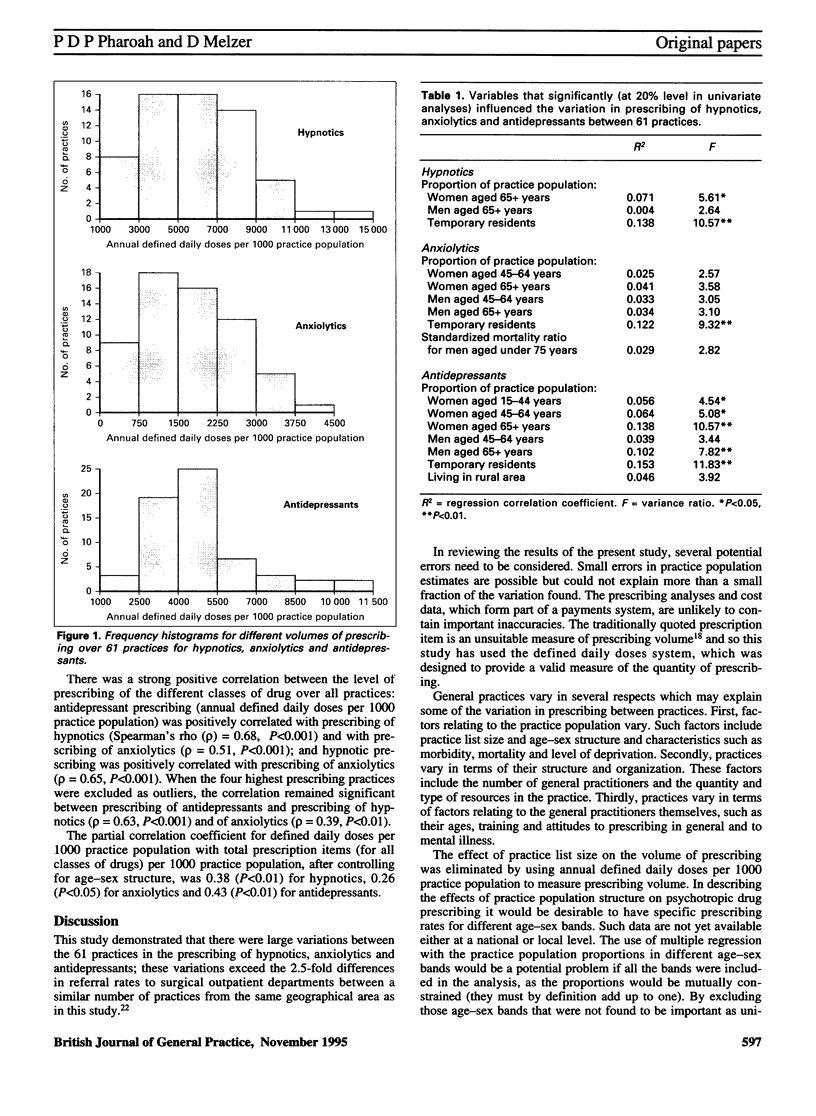Abstract
BACKGROUND. Although the desirability of reducing prescribing of hypnotics and anxiolytics has long been recognized, variation between practices in patterns of psychotropic drug prescribing has received little attention; factors underlying such variation are poorly understood. AIM. The study aimed to describe the extent of variation between general practices in the prescribing of hypnotics, anxiolytics and antidepressants; it also aimed to analyse the influence of measures of practice population and general practice and general practitioner characteristics on any variation in prescribing volumes. METHOD. Routinely collected prescribing data and practice population data, from April 1992 to March 1993, from all 61 practices in the Cambridge and Huntingdon Health Commission were analysed. Prescribing was measured as annual defined daily doses per 1000 practice population for each drug class. Data on variables relating to practice structure and general practitioner characteristics were obtained and analysed. Potentially influencing variables were investigated by multiple regression. RESULTS. Between the highest and lowest prescribing practices there was an 11-fold difference, a 13-fold difference and an eightfold difference in the annual defined daily doses per 1000 practice population prescribed for hypnotics, for anxiolytics and for antidepressants, respectively. Strong positive correlations existed between volumes of prescribing of each drug class. The drugs prescribed in the greatest volumes were hypnotics. Practice population structure had some influence on psychotropic drug prescribing with high prescribing being associated with the proportions of temporary residents and women aged 65 years and over in the practice for all three classes of drug. Other factors, including presence of a practice counsellor, were not found to have a significant influence on psychotropic drug prescribing. CONCLUSION. The degree of variation in prescribing volumes of psychotropic drugs between practices raises serious concerns. Further study is needed, but progress will be hampered until there is more clarity over the effectiveness and appropriateness of using these substances in the various illness, symptom and life-stress presentations seen in primary care.
Full text
PDF




Selected References
These references are in PubMed. This may not be the complete list of references from this article.
- Bogle S. M., Harris C. M. Measuring prescribing: the shortcomings of the item. BMJ. 1994 Mar 5;308(6929):637–640. doi: 10.1136/bmj.308.6929.637. [DOI] [PMC free article] [PubMed] [Google Scholar]
- Bradley C. P. Decision making and prescribing patterns--a literature review. Fam Pract. 1991 Sep;8(3):276–287. doi: 10.1093/fampra/8.3.276. [DOI] [PubMed] [Google Scholar]
- Catalan J., Gath D. H., Bond A., Edmonds G., Martin P., Ennis J. General practice patients on long-term psychotropic drugs. A controlled investigation. Br J Psychiatry. 1988 Mar;152:399–405. doi: 10.1192/bjp.152.3.399. [DOI] [PubMed] [Google Scholar]
- Cormack M. A., Sweeney K. G., Hughes-Jones H., Foot G. A. Evaluation of an easy, cost-effective strategy for cutting benzodiazepine use in general practice. Br J Gen Pract. 1994 Jan;44(378):5–8. [PMC free article] [PubMed] [Google Scholar]
- Davis P. B., Yee R. L., Millar J. Accounting for medical variation: the case of prescribing activity in a New Zealand general practice sample. Soc Sci Med. 1994 Aug;39(3):367–374. doi: 10.1016/0277-9536(94)90133-3. [DOI] [PubMed] [Google Scholar]
- Fertig A., Roland M., King H., Moore T. Understanding variation in rates of referral among general practitioners: are inappropriate referrals important and would guidelines help to reduce rates? BMJ. 1993 Dec 4;307(6917):1467–1470. doi: 10.1136/bmj.307.6917.1467. [DOI] [PMC free article] [PubMed] [Google Scholar]
- Freeling P., Rao B. M., Paykel E. S., Sireling L. I., Burton R. H. Unrecognised depression in general practice. Br Med J (Clin Res Ed) 1985 Jun 22;290(6485):1880–1883. [PMC free article] [PubMed] [Google Scholar]
- Gabe J., Williams P. Rural tranquility?: urban-rural differences in tranquilliser prescribing. Soc Sci Med. 1986;22(10):1059–1066. doi: 10.1016/0277-9536(86)90206-6. [DOI] [PubMed] [Google Scholar]
- Holm M., Olesen F. Factors affecting prescription of psychotropic drugs in general practice. Scand J Prim Health Care. 1988 Sep;6(3):169–173. doi: 10.3109/02813438809009311. [DOI] [PubMed] [Google Scholar]
- Mant A., Duncan-Jones P., Saltman D., Bridges-Webb C., Kehoe L., Lansbury G., Chancellor A. H. Development of long term use of psychotropic drugs by general practice patients. Br Med J (Clin Res Ed) 1988 Jan 23;296(6617):251–254. doi: 10.1136/bmj.296.6617.251. [DOI] [PMC free article] [PubMed] [Google Scholar]
- Marks J., Nicholson A. N. Drugs and insomnia. Br Med J (Clin Res Ed) 1984 Jan 28;288(6413):261–261. doi: 10.1136/bmj.288.6413.261. [DOI] [PMC free article] [PubMed] [Google Scholar]
- Maxwell M., Heaney D., Howie J. G., Noble S. General practice fundholding: observations on prescribing patterns and costs using the defined daily dose method. BMJ. 1993 Nov 6;307(6913):1190–1194. doi: 10.1136/bmj.307.6913.1190. [DOI] [PMC free article] [PubMed] [Google Scholar]
- McGavock H. Some patterns of prescribing by urban general practitioners. Br Med J (Clin Res Ed) 1988 Mar 26;296(6626):900–902. doi: 10.1136/bmj.296.6626.900. [DOI] [PMC free article] [PubMed] [Google Scholar]
- Owen R. T., Tyrer P. Benzodiazepine dependence. A review of the evidence. Drugs. 1983 Apr;25(4):385–398. doi: 10.2165/00003495-198325040-00003. [DOI] [PubMed] [Google Scholar]
- Skegg D. C., Doll R., Perry J. Use of medicines in general practice. Br Med J. 1977 Jun 18;1(6076):1561–1563. doi: 10.1136/bmj.1.6076.1561. [DOI] [PMC free article] [PubMed] [Google Scholar]
- Taylor R. J. General-practitioner prescribing. J R Coll Gen Pract. 1977 Feb;27(175):79–82. [PMC free article] [PubMed] [Google Scholar]
- Trethowan W. H. Pills for personal problems. Br Med J. 1975 Sep 27;3(5986):749–751. doi: 10.1136/bmj.3.5986.749. [DOI] [PMC free article] [PubMed] [Google Scholar]
- Tyrer P. J. Benzodiazepines on trial. Br Med J (Clin Res Ed) 1984 Apr 14;288(6424):1101–1102. doi: 10.1136/bmj.288.6424.1101. [DOI] [PMC free article] [PubMed] [Google Scholar]
- Williams P., Murray J., Clare A. A longitudinal study of psychotropic drug prescription. Psychol Med. 1982 Feb;12(1):201–206. doi: 10.1017/s0033291700043464. [DOI] [PubMed] [Google Scholar]


